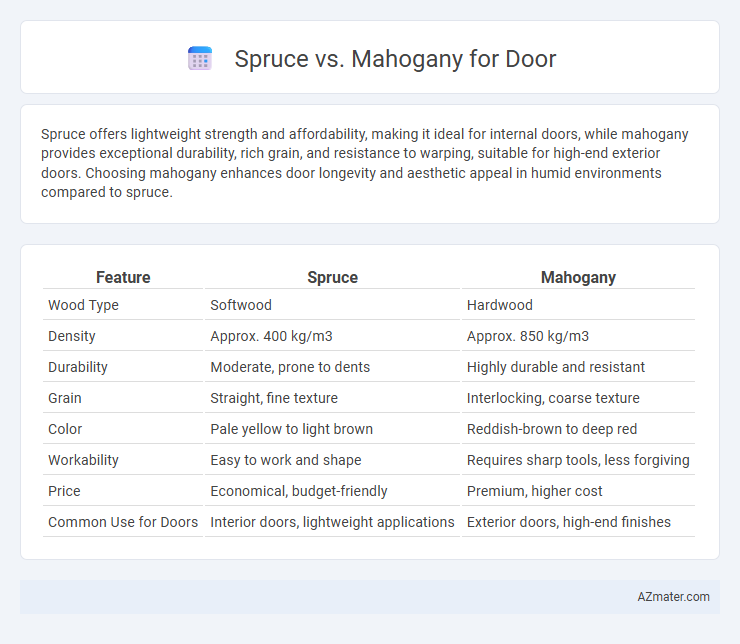Spruce offers lightweight strength and affordability, making it ideal for internal doors, while mahogany provides exceptional durability, rich grain, and resistance to warping, suitable for high-end exterior doors. Choosing mahogany enhances door longevity and aesthetic appeal in humid environments compared to spruce.
Table of Comparison
| Feature | Spruce | Mahogany |
|---|---|---|
| Wood Type | Softwood | Hardwood |
| Density | Approx. 400 kg/m3 | Approx. 850 kg/m3 |
| Durability | Moderate, prone to dents | Highly durable and resistant |
| Grain | Straight, fine texture | Interlocking, coarse texture |
| Color | Pale yellow to light brown | Reddish-brown to deep red |
| Workability | Easy to work and shape | Requires sharp tools, less forgiving |
| Price | Economical, budget-friendly | Premium, higher cost |
| Common Use for Doors | Interior doors, lightweight applications | Exterior doors, high-end finishes |
Introduction to Spruce and Mahogany Doors
Spruce doors are valued for their lightweight structure, affordability, and natural resistance to shrinking, making them ideal for interior applications where budget and ease of handling are important. Mahogany doors offer exceptional durability, rich reddish-brown color, and natural resistance to decay and insects, providing a luxurious, long-lasting option primarily suited for exterior or high-end interior doors. Both woods present distinct grain patterns and finishing capabilities, with spruce showcasing a fine, uniform texture and mahogany delivering a deep, polished aesthetic.
Wood Characteristics: Spruce vs Mahogany
Spruce wood is lightweight with a pale color and straight grain, making it easy to work with but less durable and more prone to dents and scratches compared to mahogany. Mahogany, known for its rich reddish-brown hue and fine, even texture, offers superior strength, resistance to decay, and excellent stability, ideal for long-lasting, elegant doors. The natural oils in mahogany also provide increased resistance to moisture and insects, whereas spruce requires additional treatment for outdoor use.
Durability and Strength Comparison
Mahogany offers superior durability and strength compared to spruce, making it a preferred choice for high-quality, long-lasting doors. Its dense grain structure provides excellent resistance to warping, cracking, and impact, ensuring enhanced stability over time. Spruce, while lighter and more affordable, lacks the robustness of mahogany and is more prone to dents and environmental damage.
Appearance and Aesthetic Appeal
Spruce doors offer a light, pale yellow to creamy white color with a straight, uniform grain that provides a clean and understated look, ideal for modern and minimalist designs. Mahogany doors feature rich, deep reddish-brown hues with a fine, straight to interlocked grain that enhances elegance and luxury in traditional or classic interiors. The warm tones and natural luster of mahogany create a sophisticated aesthetic, while spruce's lighter shade allows for versatile finishing options including bleaching, staining, or painting.
Insulation and Energy Efficiency
Spruce doors offer moderate insulation due to their softwood composition, providing decent energy efficiency but are less effective compared to hardwoods. Mahogany, a dense hardwood, excels in thermal insulation, reducing heat transfer and improving overall energy efficiency in buildings. Choosing mahogany doors enhances temperature regulation and lowers energy costs due to superior natural insulating properties.
Maintenance Requirements
Spruce doors require more frequent maintenance due to their softer wood structure, needing regular sealing and painting to prevent moisture damage and warping. Mahogany doors are naturally resistant to rot and insect damage, demanding less upkeep while maintaining their rich appearance with occasional polishing and sealing. Choosing mahogany reduces long-term maintenance costs and effort compared to the higher maintenance frequency of spruce doors.
Cost Differences
Spruce doors typically offer a more budget-friendly option compared to mahogany, with spruce costing approximately $3 to $5 per board foot, while mahogany ranges from $8 to $12 per board foot. The lower price of spruce is due to its faster growth rate and wider availability, making it ideal for cost-conscious projects. Mahogany's higher cost reflects its durability, rich color, and superior resistance to decay, often justifying the investment for premium door applications.
Environmental Impact and Sustainability
Spruce doors typically have a lower environmental impact due to faster growth rates and higher availability, making them a more sustainable choice compared to mahogany, which grows slowly and is often harvested from tropical rainforests. Mahogany's extraction can lead to deforestation and biodiversity loss, whereas responsibly sourced spruce from managed forests supports carbon sequestration and ecosystem regeneration. Choosing FSC-certified spruce ensures reduced environmental footprint and promotes sustainable forestry practices.
Best Applications for Each Wood Type
Spruce doors offer lightweight strength and excellent insulation, making them ideal for interior doors and climate-controlled environments where cost-efficiency and ease of installation are priorities. Mahogany doors provide superior durability, rich color, and natural resistance to decay, making them the best choice for exterior doors and high-traffic entryways requiring long-lasting aesthetics and weather resistance. Choosing between spruce and mahogany depends on the specific demands of the door's location, balancing factors like durability, appearance, and environmental exposure.
Final Thoughts: Choosing Between Spruce and Mahogany
Spruce offers a lightweight, cost-effective option with excellent workability and a pale, natural finish ideal for modern, minimalist door designs. Mahogany provides superior durability, rich color, and a luxurious appearance, making it a preferred choice for high-end, classic, or traditional doors that demand long-lasting strength. The decision between spruce and mahogany hinges on budget considerations, aesthetic preferences, and the desired longevity of the door in its specific environment.

Infographic: Spruce vs Mahogany for Door
 azmater.com
azmater.com